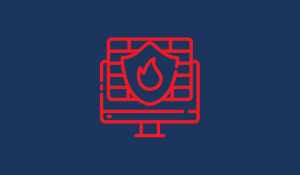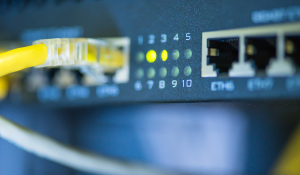The Ultimate Guide to IT Firewalls
Are you ready to fortify your digital defenses and safeguard your network from cyberattacks? Look no further than the network firewall. A formidable...

Cyber threats are constantly on the rise and organisations are faced with the challenge of protecting their networks from a wide range of attacks and security breaches. One of the most basic and effective measures for securing networks is packet filtering.
| TABLE OF CONTENT |
But what exactly is packet filtering and why is it so important for network security? Find out all about how packet filtering works and how it contributes to network security.
Packet filtering is an important part of network security. It is a process in which network data packets are checked based on certain rules and criteria and either accepted or rejected.
The main purpose of packet filtering is to monitor traffic and block unwanted or malicious traffic. This ensures the security of the network and prevents potential threats.
Packet filtering works by analysing data traffic based on predefined rules and criteria. Every data packet entering or leaving the network is checked to determine whether it complies with the defined rules.
The rules can be applied at different levels, e.g. based on IP addresses, protocols, ports or specific content. If a data packet matches the rules, it is accepted and forwarded. Otherwise, it is rejected and discarded.
Packet filtering can be carried out at different levels of the network, e.g. at firewall level or at router level. By blocking unwanted data traffic, packet filtering contributes to network security and protects against potential attacks.
There are different types of packet filters that can be selected depending on the requirements and security level of the network.
Stateful Packet Filter: This packet filter analyses the status of each data packet and takes into account the connection status of the network. This enables it to make intelligent decisions about data traffic.
Stateless Packet Filter: This packet filter considers each data packet individually and analyses it independently of other packets. No information about the connection status is taken into account.
Application-Level Gateway: This packet filter works at application level and analyses the content of the data packets. It can monitor certain application protocols and apply specific rules for the data traffic of these applications.
Circuit-Level Gateway: This packet filter checks the connection setup between two networks and authenticates the communication. It only allows data traffic between trusted sources and destinations.
Depending on the requirements and the network infrastructure, different types of packet filters can be used to ensure the security of the network.
Packet filtering offers several advantages for network security:
Network security: Packet filters make it possible to monitor and control the data traffic that passes through a network. This allows potentially harmful or unwanted data packets to be blocked to ensure the security of the network.
Access control: Packet filters allow administrators to restrict access to certain services or resources based on various criteria such as IP address, port number or protocol type. This enables fine-grained control over data traffic on the network.
Prevention of denial of service (DoS) attacks: Packet filters can be configured to detect and block traffic from potential attackers attempting to overload the network with excessive traffic.
Preventing malware: By implementing packet filters, harmful data packets containing viruses, worms or other types of malware can be detected and blocked before they can reach the network and cause damage.
Optimising network performance: Packet filters can be used to control traffic and block unwanted or unauthorised activity. This can help improve network performance by reducing bandwidth bottlenecks and optimising resources for legitimate traffic.
Compliance with policies and regulations: Packet filters can help ensure compliance with security policies and industry-specific regulations by filtering and controlling traffic according to established policies.
By taking advantage of packet filtering, network security can be improved and the risk of security breaches minimised.
To use packet filtering effectively and maximise network security, the following tips can be followed:
1 |
Regular review of the safety rules: It is important to regularly check and update the security rules for packet filtering. New threats and requirements may necessitate changes to the rules. |
2 |
Use of multiple packet filters: By using several packet filters, different types of threats can be covered. This further improves the security of the network. |
3 |
Use of encryption: To ensure the confidentiality of data, it is advisable to use encryption technologies. This prevents confidential information from being intercepted or manipulated during transmission. |
4 |
Employee training: It is important to train employees on the importance of packet filtering and security best practices. This will increase awareness of network security and reduce the risk of security breaches. |
5 |
Implement multi-level filtering: Use multi-level filtering to detect and block different types of threats at different levels of the network. This can help to improve the effectiveness of packet filtering and minimise security gaps. |
6 |
Logging and monitoring: Enable logging for your packet filters to log traffic and detect suspicious activity. Monitor the logs regularly to identify anomalies or potential security incidents. |
By following these tips, you can improve the effectiveness of your packet filtering and increase the security of your network at the same time.
Overall, packet filtering is an essential part of any comprehensive network security strategy. By implementing packet filtering, organisations can protect their networks from a variety of threats and maintain the integrity and confidentiality of their data while optimising the performance and availability of their network.
By carefully planning, implementing and regularly reviewing your packet filtering rules, you can ensure that your network is optimally protected while supporting your organisation's performance and productivity. In a world where threats are constantly increasing, a proactive and robust network security strategy is essential to successfully meet the challenges of the cyber world.

Are you ready to fortify your digital defenses and safeguard your network from cyberattacks? Look no further than the network firewall. A formidable...

An IP address is the cornerstone of digital communication in any working environment and serves as a unique identifier for devices connected to a...

One of the key technologies that helps to protect networks from unauthorized access and potential attacks is stateful inspection. But what exactly is...